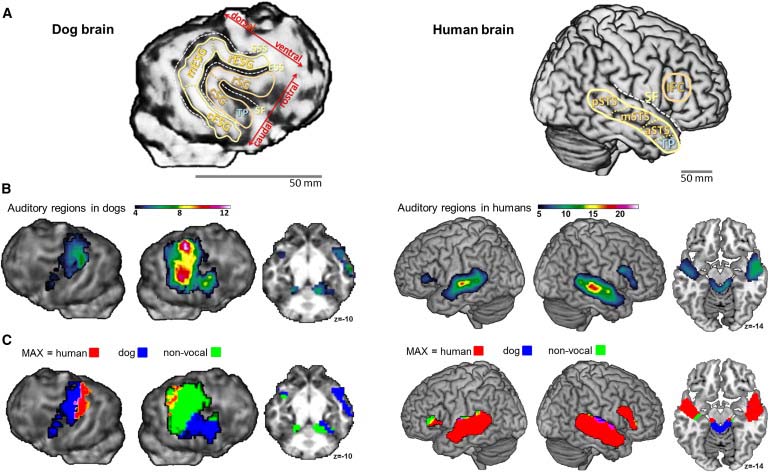Does Your Dog Get You?
Nearly all dog owners talk to their pets, but how much meaning do the dogs absorb? Certainly dogs understand how to follow commands we’ve taught them, but it’s difficult to tell how far their comprehension goes beyond this rudimentary level.
Did you know that there are so-called “language research dogs” that help scientists better understand the intricacies of communication between dogs and humans? We’ll now take a look at some of the research behind these dogs and the experiments that cognitive scientists have gone through, and what they found.
Some owners may believe their pets get nearly everything they say, but cognitive scientists used to approach this question with skepticism. Fortunately, in recent years, some remarkable studies have expanded the known boundaries of canine-human communication and understanding of dog psychology.
Dogs may not be able to understand a discussion of politics, but they are highly tuned in to humans in the ways that count. They are using not your words (which are impossible for animals to learn), but their sounds and context, your habits, gestures, intonation and emotions to tune in to what’s important to you.
RELATED: Dog Facial Expressions and Body Language Explained by Science
Canine Language Majors
It’s fairly common for dogs to react to certain words or phrases. “You need a bath!” may cause your pooch to hide under the couch, while “Want to go for a walk?” can result in a frenzy of tail wags and ecstatic leaps.
The question is, to what extent does the dog really decode these sentences?
Is it only the words “bath” and “walk” that he has deciphered? Maybe it’s just the intonation and your unconscious gestures such as wrinkling your nose or moving towards the leash. Fortunately, scientists have been hard at work on this for the last few decades.
To tease apart which elements of language a dog is capable of understanding, researchers and cognitive scientists of Canine Cognition Center at Yale University have been performing controlled experiments with pet dogs to understand the intricacies of canine body language, cognition and facial expressions. Similarly, two border collies, Rico and Chaser, have accomplished remarkable achievements in understanding human language, and we’ll discuss some of the findings below.
Border collies are a working breed, and there’s one study in particular that proves it well (Pilley et al. 2011). While herding sheep, a border collie will follow the shepherd’s gestures and verbal commands to circle clockwise, counterclockwise, drop to their bellies, step forward, and so on. They understand verbal commands, gestures or even separate whistles for each command (used when those commands must travel across long distances).
Given the understanding required to execute these behaviors, it’s not surprising that this breed has excelled in language research. Some shepherds say their dogs know the names of the individual sheep, and Rico and Chaser show the possibility of this claim. Popular Science magazine has written an article about them.
There’s also a video you can check out below:
Here’s a brief:
Rico was able to learn the names of over 200 toys and fetch the one that was called for. Chaser later trounced this record decisively, learning the names of over 1,000 toys in this experiment (Pilley et al. 2011). In fact, Chaser’s trainer had to admit she had him beat as well, and he had to label each toy because he couldn’t keep them all straight!
When asked to fetch this toy again, they could remember the name, thus showing that they had learned the word using the technique called “fast-mapping.”
Both Rico and Chaser were able to learn the names of new toys by exclusion, a method that human toddlers use to learn new words. If they were told to fetch a toy with a name they had never heard before, they would choose the toy they had never seen before.
Chaser was able to learn categories as well. For example, while each of her balls had a unique name, she was also able to learn the word “ball,” and get a ball on request rather than a Frisbee. She could be told that an object was or was NOT a toy, and then would understand to leave the non-toys alone.
It isn’t clear whether Rico learned the idea of “fetch” as an action separate from the rest of the command, but because Chaser learned three possible actions to perform (get, paw, and nose) she could show that she understood each word in her command sentences.
When given a new combination such as “paw (the toy named) Blue” she could perform the action correctly the first time, showing that she understood noun-verb sentences as two separate words rather than a single command.
As if that weren’t enough, she moved on to three-part sentences with direct objects, which was observed in a different later study (Pilley, 2013). Chaser could correctly execute commands such as “to Frisbee take ball” and “to ball take Frisbee,” showing that she understood that the syntax of the sentence produced two different meanings for the same words.
Language research dogs such as Chaser are the canine equivalent of PhDs. Your dog may know many words, but isn’t likely to have such a sophisticated understanding of human language without the hours of daily training that Chaser enjoys.
According to her trainers and scientists, Border collies are workaholics. Chaser herself often begs for more action because it’s all a game for her.
If you want to train your dog to understand language better, focus on concrete words that describe objects or actions, and be consistent with your word use. If you want your dog to understand that “quiet” means to stop making noise, then don’t say “Shush!” half the time instead. Further research shows your dog is more likely to pay attention to what you say if you first make it clear you’re addressing him (Teglas et al. 2012).

Getting Brainy
In humans, the left half of the brain detects the meaning of language and the right half detects the emotion in the words. The halves are cross-wired, so that the left brain primarily connects to the right half of the body, and vice-versa (Price, 2009).
Researchers Victoria Ratcliffe and David Reby used these facts to design a clever way to tell whether dogs were processing speech in the same way that humans do. They placed the dogs in their experiment between two speakers. These played spoken language that the dogs were likely to understand, such as commands to come (Ratcliffe et al. 2014).
Sometimes the words were processed to remove the emotion. The dogs then turned their heads to the right to listen. The right ear is connected to the left hemisphere of the brain where meaning is detected, so this suggested that the dogs were listening for the meaning of the words.
If, instead, the sounds were rearranged to remove the meaning and make nonsense, but the emotional tone was intact, the dogs turned their heads to the left to listen, suggesting they were trying to detect the emotion using their right brain hemisphere. In ordinary speech, both meaning and emotion are present, and it appears that dogs are paying attention to both.
Dogs seem to have at least some of the same mental equipment that humans have for understanding language, as shown by fMRI scans. These scans allow imaging of blood flow in the brain to indicate regions of increased brain activity.
Dogs were first trained to sit comfortably still in the fMRI scanners, so valid readings could be taken. This was the key to the process, and training dogs for it is an art form in itself. (Here’s a video of a dog getting into an fMRI scan for those curious how it works, because I certainly was.)
After the scans were done, researchers observed that humans show activation in certain areas of the brain when listening to spoken language. When listening to humans speaking, the dogs showed some of the same brain regions were activated (Andics et al. 2014).

While dogs are clearly paying attention to what we say and trying to make sense of it, they only understand some of it. Spoken language is not the only way to communicate, and dogs can’t speak. They are meeting us on our turf when they tune in to our words, but other forms of communication come more naturally to them.
Getting Your Point
Dogs seem to have a talent for understanding human gestures that’s unmatched in the animal kingdom. While young puppies can find hidden food if a human points to it, wolves can’t without socialization and training (Viranyi et al. 2008).
This talent may have evolved due to dogs’ close association with humans (and love of treats!). Although chimpanzees score higher than dogs on many tests of intelligence, even chimps don’t understand human gestures as well as dogs according to some recent studies (Kirchhofer et al. 2012).

Who, Me?
It comes as no surprise to dog owners that their furry friends are capable of sneaking to avoid their owners’ anger when they misbehave. This behavior shows some pretty sophisticated thinking going on between those perky ears.
“Theory of mind” is the ability to take another’s point of view and realize that it might be different from our own. Kaminski and her fellow researchers at the Max Planck Institute for Evolutionary Anthropology found a way to test whether dogs could take a human’s viewpoint into account (Kaminski et al. 2013). Dogs were placed in a room with a human and a treat, and were forbidden to eat the treat. Do you sense canine conflict on the horizon?
Soon the wheels were turning as the dogs tried to figure out whether they could eat the food. But here’s the thing: only parts of the room (human or treat) were illuminated. If dogs sneak forbidden treats because they’ve forgotten they were not supposed to eat them, you’d expect that lighting up the human would remind them that the treats were forbidden fruit.
However, if dogs sneak treats because they think the human can’t see them, there you have the beginnings of a theory of mind. The dog is thinking about what the human can see and how the human will react to their thievery.
When the results were in, you guessed it, the dogs didn’t care whether the human was in the illuminated area. However, they approached the treats faster if the treats were in the darkened area (unless the dogs were alone and knew they wouldn’t be observed). Pretty smart, biscuit breath!
A Furry Shoulder to Lean On
An extraordinary number of canine studies have focused on yawning (Joly-Mascheroni et al. 2008). This might sound like frivolous research, but there is good reason for wondering whether dogs can “catch” yawns from humans.
It turns out that the ability to catch yawns from others is correlated with empathy (Platek, 2010). Psychopaths who score high for “coldheartedness” on psychological profiles are unlikely to catch a yawn from anyone, for example.
But Rover can catch your yawns, a possible indication of cross-species empathy. But, don’t worry if your significant other doesn’t catch your yawn. There are other variables involved, such as temperature and self-consciousness.
Another peculiar habit your dog has will back up this evidence for empathy. When looking at human faces, dogs (like humans) have a left gaze bias (Guo et al. 2009). That means both humans and dogs will look first, and longer, at the right side of someone’s face (on the viewer’s left), as eye-tracking studies show.
Why in the world would this happen, let alone matter?
To understand this, you have to go back to the two hemispheres of the brain. Remember, the right side of the brain processes emotions. Because much of the brain is cross-wired, the right brain is connected to your left field of vision. The left gaze bias indicates you’re processing emotional information.
When you face someone, you will automatically look to your left to read the emotions on the other person’s face. This is subconscious and nearly instantaneous. Your dog will do this when looking at you, showing that he is reading your emotions. No wonder he always knows when to snuggle up to you or try to distract you with a game.
READ NEXT: Dog Body Language – The Pet Owner’s Guide to Understanding Dogs







Link exchange is nothing else except it is only placing the other person’s weblog link on your page at proper place and other person will also do similar in support of you.
I am sure this paragraph has touched all the internet people, its really really
nice article on building up new blog.
This is very fascinating, You’re a very professional blogger.
I have joined your feed and look forward to seeking more of
your magnificent post. Additionally, I have shared
your site in my social networks
Right now it appears like Drupal is the best blogging platform out
there right now. (from what I’ve read) Is that what
you’re using on your blog?
Good post! We will be linking to this great content on our site.
Keep up the good writing.
I do accept as true with all the ideas you have introduced on your post.
They are really convincing and will certainly work.
Nonetheless, the posts are very short for newbies.
May just you please extend them a little from subsequent time?
Thank you for the post.
Unquestionably consider that that you stated.
Your favorite reason appeared to be at the web the simplest factor to take into account of.
I say to you, I certainly get irked whilst other folks think about worries that they
just do not recognise about. You controlled to hit the nail upon the highest and
defined out the whole thing with no need side effect , other folks can take a signal.
Will likely be back to get more. Thanks
Remarkable things here. I’m very happy to look your article.
Thank you a lot and I am looking forward to touch you.
Will you kindly drop me a e-mail?
This information is invaluable. Where can I find out more?
Usually I don’t learn article on blogs, but I would like to say that this write-up very forced me to try and do it!
Your writing style has been surprised me. Thank you, very great post.
I don’t know whether it’s just me or if everybody else experiencing problems with your website.
It appears as if some of the written text on your content are running off the screen.
Can somebody else please comment and let me know if this is happening to them as well?
This might be a issue with my browser because I’ve had this happen previously.
Kudos
You should take part in a contest for one of the best sites online.
I will recommend this website!
Good day! Do you know if they make any plugins to safeguard against hackers?
I’m kinda paranoid about losing everything I’ve
worked hard on. Any recommendations?
I was suggested this website by my cousin. I am not sure whether this post is written by him as nobody else
know such detailed about my trouble. You are wonderful!
Thanks!
Hi there colleagues, good paragraph and nice arguments commented at this place, I am
genuinely enjoying by these.
Yes! Finally something about Small Business Advice.